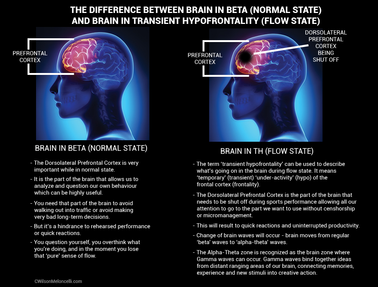FlameinMind
iTHRVE CranioSacral & Coherence & Chakras APPs
Applications for iPhone 5-7 , iPod Touch 5-7 & iPad
GROUP
CranioSacral Wave & Cranio Sacral apps for iPhones
Now available in last update (2.0)
" Brain Flow "
FOUR CHANNEL - EEG- Front versus Back brain Compare
See below examples in the research literature showing how being IN THE FLOW Works.
https://www.elephantjournal.com/2015/10/where-meditation-flow-neuroscience-spirituality-meet/
Think about when you are at your absolute best, doing something you enjoy.
Do you have to think about it, or does it just flow?
If you know what I’m talking about, you’ve likely experienced a flow state. In a flow state, consciousness dims, and in what feels like something takingover, the subconscious rises to the forefront of mind, facilitating maximum human performance. Flow is characterized by complete absorption in what one does.
Behind flow states is some complex neurobiology, at the heart of which is a brain state called transient hypofrontality. Transient hypofrontality is characterized by a temporary lessening of brain activity, particularly in the pre-frontal cortex of the brain, which is responsible for logic, decision making, self-auditing, and spatial orientation, among other very important things.
But these three are important, because in a flow state we no longer apply logic to our thoughts, we don’t really make conscious decisions—the innercritic is rendered mute—and in extreme cases one may even lose feeling of body orientation. Not only does it feel great, but also it induces personal growth like no other mode of consciousness can.
If you’re flowing, you’re growing.
http://www.higher-faster-sports.com/frontallobe.html
>> In Sports - The Hindbrain Rules
However, in the world of sport this can be one of your worst enemies. Team sports in particular tend to reward instinctive RIGHT NOW behavior, characterized by more of a reliance on the hindbrain. Many of you are not having the success in sports you want to simply because you're unable to play instinctively and "let go"....If one is thinking excessively it destroys their flow, and this is observable in athletes across all sports. The great sprint coach Charlie Francis wrote about this saying it is essential that sprinters learn how to do drills WITHOUT thinking and keep things IN their instinctive hindbrain and out of the forebrain, otherwise their movements would be too mechanical.
That part of the brain is none other than the Dorsolateral Prefrontal Cortex, yes, the one that I mentioned earlier. You need to shut down that part of your brain during sports performance to avoid distraction allowing all your attention to go to the part you want to use without restriction or micromanagement. This will then result to quick reactions and uninterrupted productivity. So in Transient Hypofrontality, we are trading conscious processing for subconscious processing where the processing of information is very fast and requires a very little energy.
..some part of your brain needs to deactivate in order to enter the zone. You need to shift your brain from normal or beta state into the Transient Hypofrontality or flow state. ‘Transient’ means temporary, ‘hypo’ means slowing down and ‘frontality’ means frontal cortex (the front of your brain). In Transient Hypofrontality, you need to shut down that ‘inner critic’ that pushes you down and distracts you instead of lifting you up and helping you focus.
https://www.psychologytoday.com/us/blog/the-edge-peak-performance-psychology/201703/the-transient-hypofrontality-edge
Teaching the front brain to relax
called HYPOFRONTALITY
related to the 'runners high' and altered states:
Transient hypofrontality, then, means that for a while, under certain conditions, the focused thinking part of our brain gets a rest…which allows other parts and functions of our brain to become more predominant.
Dr. Arne Dietrich , a professor at the American University of Beirut, came up with the term “transient hypofrontality.” He’s written extensively on the subject—even gave a TedX Talk . Dietrich suggests that physical activity “forces” the brain to redistribute brain resources (a process known as down-regulation). If you’re engaged in a competitive sport, you need to make a variety of complex decisions. Those will involve the prefrontal cortex. But if you’re on a long-distance run in a beautiful park, your mind lets go of that prefrontal engagement; you may experience an alteration in consciousness.
Here’s how Dietrich puts it: The beneficial effects of exercise on mental health, the prolonged disengagement of higher cognitive centers in the prefrontal cortex also offers a neural mechanism that provides insight into the alteration of consciousness known as the runner’s high. Some of the phenomenologically unique features of this state such as experiences of timelessness, living in the here and now, reduced awareness of one’s surroundings, peacefulness (being less analytical), and floating (diminished working memory and attentional capacities), are consistent with a state of frontal hypo-function. Even abstruse feelings such as the unity with the self and/or nature might be more explicable, considering that the prefrontal cortex is the very structure that provides us with the ability to segregate, differentiate, and analyze the environment.
https://www.elephantjournal.com/2015/05/hacking-enlightenment-with-flow-states/
Flow is an optimal state of consciousness where we feel great and perform our greatest. They occur when we are in the zone, experience runner’s high, and our sense of “self vanishes, time slows down, and action and awareness merge” Sound familiar? It’s the way of wei wu wei.
In flow, a phenomenon called transient hypofrontality occurs where parts of the prefrontal cortex quiet down and the subconscious mind becomes the information processor. Additionally, a waterfall of potent chemicals —norepinephrine, dopamine, nitric oxide, endorphins, anandamide, and serotonin—flood the system to create a blissful euphoria, a high like no other on the planet.
https://www.elephantjournal.com/2015/10/where-meditation-flow-neuroscience-spirituality-meet/









